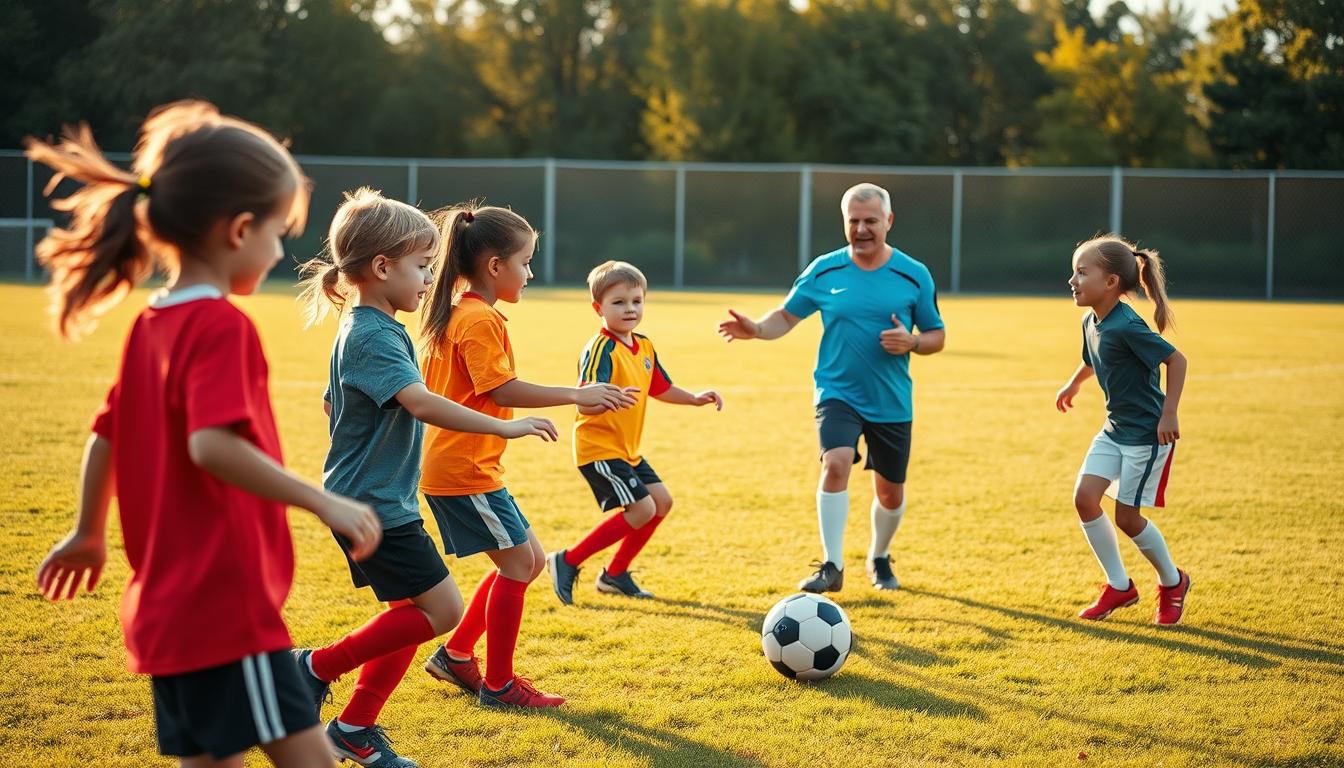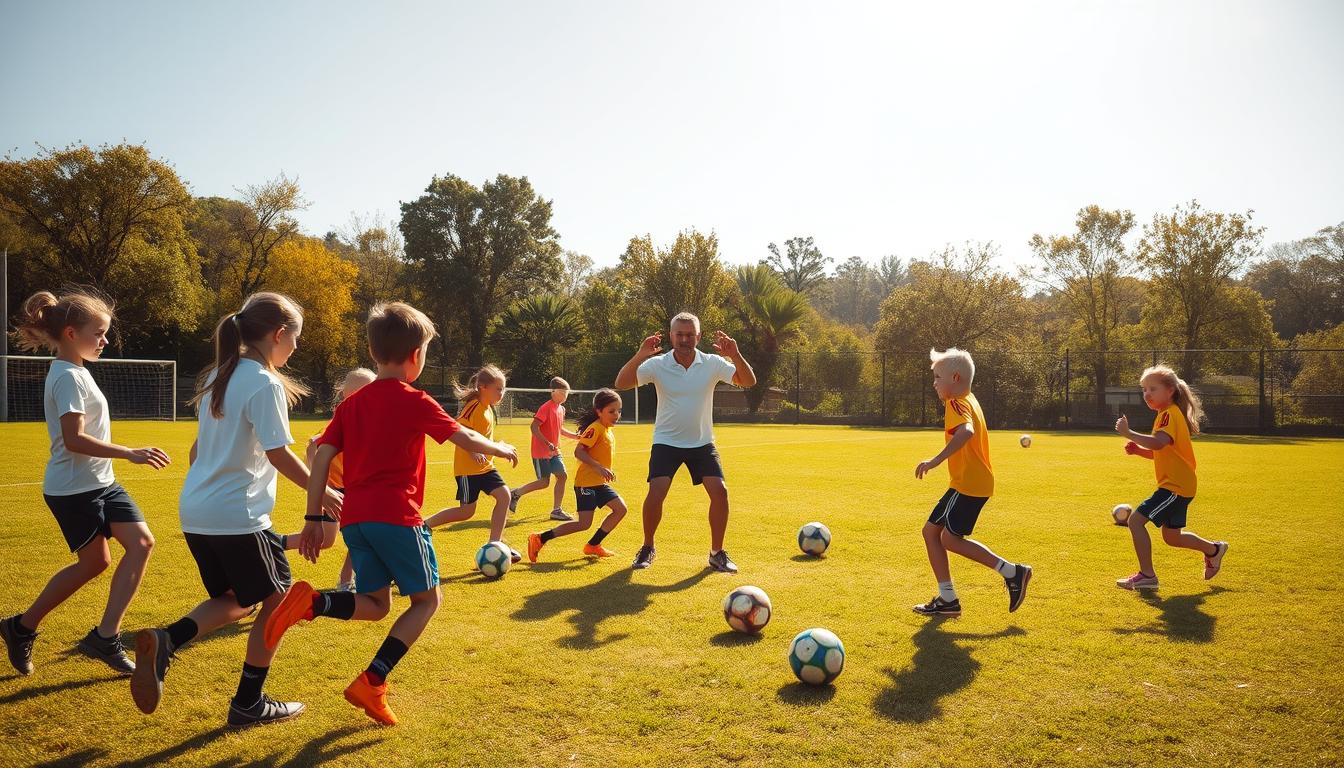Top 10 Soccer Teamwork Lessons for Kids

Imagine your child mastering skills that go beyond the field—like trust, leadership, and collaboration. Soccer teamwork lessons for kids aren’t just about scoring goals. They shape how young athletes communicate, solve problems, and support others. Whether you’re a coach or a parent, these insights will help turn practices into life-changing experiences.
This guide covers 10 actionable strategies to boost cooperation among players. You’ll learn drills from trusted resources like “The Numbers Game” and discover how simple exercises build trust. We’ll explore both on-field tactics and off-field values, showing how clear communication translates to better game-day results—and stronger friendships.
Key Takeaways
- Team activities teach communication and shared responsibility
- Drills from expert sources improve coordination quickly
- Lessons extend beyond sports to everyday challenges
- Cooperation strengthens both performance and relationships
- Practical examples make learning engaging for young players
The Value of Working Together on the Field
Young athletes thrive when they understand how their actions impact others. Structured group activities create opportunities to practice coordination while building trust through shared effort.
Importance of Clear Communication
Simple drills like “Number Calls” teach players to vocalize decisions. When a coach shouts “Group 3!”, teammates quickly huddle based on pre-assigned numbers. This sharpens listening skills and reduces confusion during fast-paced games.
Effective communication prevents overlaps in positioning. Players learn to call out open spaces or alert others to opponents. These habits minimize errors and keep everyone focused on common goals.
Sharing Responsibilities Effectively
The “Team Stand-Up” drill demonstrates shared effort. Sitting back-to-back, players must rise together using only coordinated movements. It shows how individual balance affects group success.
Assigning roles like “corner defender” or “passing specialist” helps young athletes value their contributions. When each member knows their job, the team moves like interconnected gears—smooth and unstoppable.
Coaches can reinforce this by rotating positions during practice. Players gain appreciation for different roles while discovering how flexibility strengthens the whole group.
Encouraging Trust and Collaboration Among Young Players
Building trust among teammates starts with shared experiences that turn strangers into allies. When young players feel connected, they’re more likely to pass the ball in tight spots or celebrate each other’s wins. This bond doesn’t happen overnight—it grows through intentional team-building activities that blend fun with purpose.
Simple Team-Building Exercises
The Human Knot is a classic drill where groups untangle themselves without letting go. It teaches problem-solving and patience while showing how every move affects the team. Another favorite is the Page of Compliments, where athletes write encouraging notes about each other. This builds confidence and a sense of belonging.
These exercises do more than break the ice. They create shared goals—like finishing a puzzle relay or navigating blindfolded through cones. Players learn to listen, adapt, and rely on others. Coaches can use these drills to address challenges, like shyness or frustration, by emphasizing progress over perfection.
Best part? Most require no special equipment. A positive atmosphere keeps things light, letting young players grow without pressure. Over time, this collaboration translates to smoother passes, quicker recoveries, and genuine friendships that last beyond the season.
Soccer teamwork lessons for kids: Engaging Activities for Team Bonding
Turn practice into playtime with activities that spark laughter and connection. These drills blend skill-building with group challenges, making cooperation feel like an adventure rather than homework.

Fun Practice Drills
Soccer Putt-Putt transforms the field into a mini-golf course. Players navigate their ball around cones using precise taps, calling out directions like “left pocket!” or “right tunnel!” This sharpens ball control while requiring clear communication.
Another favorite is Stick Together Tag. Two players link arms while chasing others. When they tag someone, the trio stays connected. The growing chain learns to move as one unit, laughing as they strategize turns and speed.
Dynamic Group Games
Try the Passing Relay Race. Teams line up behind cones 10 yards apart. The first player dribbles to their teammate, passes accurately, then joins the end of the line. Quick transitions keep energy high while reinforcing passing fundamentals.
For older groups, 3-Goal Chaos adds excitement. Three small nets are placed randomly on the field. Teams score by passing through any goal to a waiting teammate. This teaches spatial awareness and adaptability under pressure.
These activities prove that skill development thrives in joyful environments. When players associate drills with camaraderie, they naturally invest more effort. Bonus? You’ll hear phrases like “I’ve got your back!” long after practice ends.
Teaching Valuable Life Lessons Through Soccer
Every match offers more than just a score—it’s a classroom for character. Young athletes discover how effort and attitude shape their growth, both on the field and in daily life. Let’s explore how simple moments during play build lifelong values.
Turning Challenges Into Triumphs
A game loss teaches grace. A missed pass becomes a lesson in grit. These experiences help children understand that success isn’t just about winning—it’s about showing up with heart.
| Soccer Scenario | Life Lesson | How Coaches/Parents Help |
|---|---|---|
| Losing a close match | Respecting opponents | Highlight effort over outcomes |
| Missing a penalty kick | Bouncing back stronger | Practice positive self-talk |
| Celebrating a teammate’s goal | Shared joy builds bonds | Model enthusiastic support |
Small setbacks—like slipping during a drill—become opportunities to problem-solve. Coaches and parents can reinforce this by asking, “What will you try next time?” instead of focusing on errors.
Want to turn these moments into skill-building parts of practice? Check our guide on effective drills that blend technique with character. Remember, the best team victories happen when players carry these lessons beyond the field.
Effective Tips for Coaches and Parents to Boost Teamwork
Great team dynamics start with intentional guidance from adults. Whether you’re leading drills or cheering from the sidelines, your approach shapes how young athletes collaborate. Let’s break down strategies that build chemistry while saving time and energy.
Practical Guidance for Coaches
Run “Pass & Move Circles” during warm-ups. Groups of five pass rapidly while rotating positions—this sharpens awareness and quick decision-making. Rotate captains weekly to let different players lead stretches or demo drills.
Try Role Swap Scrimmages every third practice. Defenders become forwards, goalkeepers join midfield. This builds empathy and reveals hidden strengths. Pair quieter athletes with vocal partners to balance communication.
Quick Tips for Parents
Celebrate effort, not just goals. Phrases like “Your passes were spot-on!” reinforce skill development. Avoid sideline coaching—let players solve problems themselves during games.
Host casual post-game chats. Ask open questions: “What felt smooth today?” or “How did you help a teammate?” This encourages reflection without pressure. Share positive observations with coaches to align support.
Structured plans beat random drills. Use free tools like SportSessionPlanner for 15-minute activities targeting specific skills. Consistency matters more than marathon practices—three focused 30-minute sessions weekly yield better results than one chaotic hour.
Final Reflections on Building a Strong Soccer Team
The journey from individual players to a cohesive unit starts with small steps. Drills like “Number Calls” and “Human Knot” teach young athletes to listen, adapt, and value each other’s strengths. These moments lay the foundation for trust—the glue that turns groups into teams.
Success isn’t just about scoring goals. It’s built through clear roles, shared effort, and celebrating progress. Whether practicing footwork techniques or navigating 3-Goal Chaos, every activity reinforces life skills. Players learn that cooperation off the field fuels sharper passes during games.
Coaches and parents play a vital role. By focusing on effort over outcomes, you help athletes see challenges as growth opportunities. Rotating positions, hosting reflection chats, and modeling support create environments where teamwork thrives naturally.
Ready to transform your team? Start with one drill from this guide. Watch how communication blossoms, roles clarify, and laughter fills the air. Remember: strong squads aren’t born—they’re built through consistent, joyful effort.
